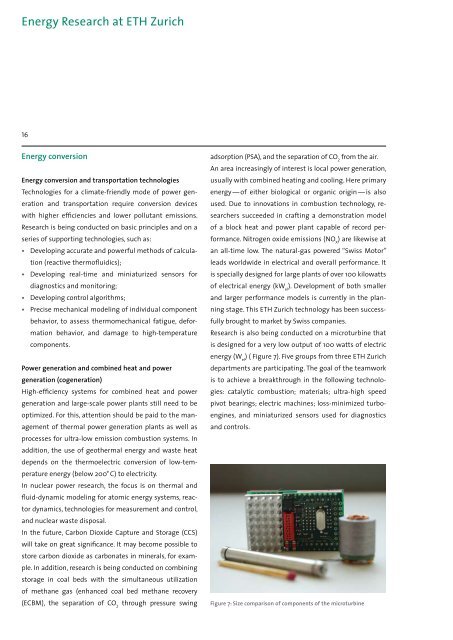Energy Strategy for ETH Zurich
Energy Strategy for ETH Zurich
Energy Strategy for ETH Zurich
You also want an ePaper? Increase the reach of your titles
YUMPU automatically turns print PDFs into web optimized ePapers that Google loves.
<strong>Energy</strong> Research at <strong>ETH</strong> <strong>Zurich</strong><br />
16<br />
<strong>Energy</strong> conversion<br />
<strong>Energy</strong> conversion and transportation technologies<br />
Technologies <strong>for</strong> a climate-friendly mode of power generation<br />
and transportation require conversion devices<br />
with higher efficiencies and lower pollutant emissions.<br />
Research is being conducted on basic principles and on a<br />
series of supporting technologies, such as:<br />
• Developing accurate and powerful methods of calcula-<br />
•<br />
•<br />
•<br />
tion (reactive thermofluidics);<br />
Developing real-time and miniaturized sensors <strong>for</strong><br />
diagnostics and monitoring;<br />
Developing control algorithms;<br />
Precise mechanical modeling of individual component<br />
behavior, to assess thermomechanical fatigue, de<strong>for</strong>-<br />
mation behavior, and damage to high-temperature<br />
components.<br />
Power generation and combined heat and power<br />
generation (cogeneration)<br />
High-efficiency systems <strong>for</strong> combined heat and power<br />
generation and large-scale power plants still need to be<br />
optimized. For this, attention should be paid to the management<br />
of thermal power generation plants as well as<br />
processes <strong>for</strong> ultra-low emission combustion systems. In<br />
addition, the use of geothermal energy and waste heat<br />
depends on the thermoelectric conversion of low-temperature<br />
energy (below 200° C) to electricity.<br />
In nuclear power research, the focus is on thermal and<br />
fluid-dynamic modeling <strong>for</strong> atomic energy systems, reactor<br />
dynamics, technologies <strong>for</strong> measurement and control,<br />
and nuclear waste disposal.<br />
In the future, Carbon Dioxide Capture and Storage (CCS)<br />
will take on great significance. It may become possible to<br />
store carbon dioxide as carbonates in minerals, <strong>for</strong> example.<br />
In addition, research is being conducted on combining<br />
storage in coal beds with the simultaneous utilization<br />
of methane gas (enhanced coal bed methane recovery<br />
(ECBM), the separation of CO through pressure swing<br />
2<br />
adsorption (PSA), and the separation of CO from the air.<br />
2<br />
An area increasingly of interest is local power generation,<br />
usually with combined heating and cooling. Here primary<br />
energy — of either biological or organic origin — is also<br />
used. Due to innovations in combustion technology, researchers<br />
succeeded in crafting a demonstration model<br />
of a block heat and power plant capable of record per<strong>for</strong>mance.<br />
Nitrogen oxide emissions (NO ) are likewise at<br />
X<br />
an all-time low. The natural-gas powered “Swiss Motor”<br />
leads worldwide in electrical and overall per<strong>for</strong>mance. It<br />
is specially designed <strong>for</strong> large plants of over 100 kilowatts<br />
of electrical energy (kW ). Development of both smaller<br />
el<br />
and larger per<strong>for</strong>mance models is currently in the planning<br />
stage. This <strong>ETH</strong> <strong>Zurich</strong> technology has been successfully<br />
brought to market by Swiss companies.<br />
Research is also being conducted on a microturbine that<br />
is designed <strong>for</strong> a very low output of 100 watts of electric<br />
energy (W ) ( Figure 7). Five groups from three <strong>ETH</strong> <strong>Zurich</strong><br />
el<br />
departments are participating. The goal of the teamwork<br />
is to achieve a breakthrough in the following technologies:<br />
catalytic combustion; materials; ultra-high speed<br />
pivot bearings; electric machines; loss-minimized turboengines,<br />
and miniaturized sensors used <strong>for</strong> diagnostics<br />
and controls.<br />
Figure 7: Size comparison of components of the microturbine
















